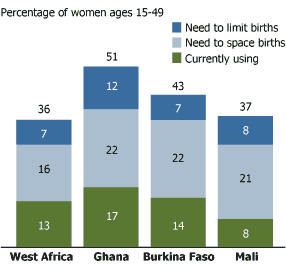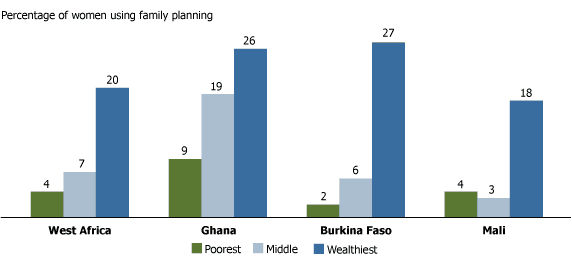
Family Planning in Ghana, Burkina Faso, and Mali
Date
April 1, 2008
Author
(April 2008) West Africa has one of the most rapidly growing populations in the world, and on average, women here have 5.7 births during their lifetimes. The 16 countries in this region represent a variety of cultural and historic backgrounds. Their residents may speak French, English, or Portuguese, in addition to one or more indigenous languages.1 These countries have different health systems, levels of political commitment to family planning, and numbers and types of health care providers—all of which can contribute to differences in family planning use.
In West Africa, approximately 13 percent of married women use some form of family planning. Hormonal contraceptives, including the pill and injections, are the most commonly used methods. Traditional family planning methods, including periodic abstinence and withdrawal, are in second place.
In addition to those women using family planning, approximately 23 percent indicate that they would like to avoid become pregnant in the near future, but are not using a family planning method. In West Africa, the wealthier a woman is, the more likely she is to use family planning. These findings, which were presented in the first article in this series, “Family Planning in West Africa,” provide insight into the region as a whole. Ghana, Burkina Faso, and Mali illustrate the richness that can be found when regional numbers are teased apart. (Data are drawn from the Population Reference Bureau’sFamily Planning Worldwide 2008.)
Contraceptive Use and Choice of Methods
In Ghana, 16.7 percent of married women ages 15 to 49 use contraceptives. Among women who use a form of family planning, more than three in every four opt for a modern method. The most popular methods are oral and injectable contraceptives (shown as hormonal methods).
Percent of Married Women 15-49 Who Use Family Planning, by Method, West Africa and
Selected Countries, 2003-2005
| West Africa (averages) | Ghana | Burkina Faso | Mali | |
|---|---|---|---|---|
| Modern Methods | ||||
| Hormonal | 5 | 10.5 | 4.7 | 4.9 |
| IUD | 1 | 0.3 | 0.4 | 0.2 |
| Condom | 2 | 1.5 | 2.1 | 0.3 |
| Other Modern | 1 | 1.8 | 1.4 | 1.6 |
| Traditional Methods | 4 | 2.6 | 5.0 | 1.1 |
| Total, All Methods* | 13 | 16.7 | 13.8 | 8.1 |
*Percentage shown in table may not add to “total, all methods” because of rounding.
Note: Hormonal methods include the pill and injection.
Source: Donna Clifton, Toshiko Kaneda, and Lori Ashford, Family Planning Worldwide 2008.
In Burkina Faso, 13.8 percent of married women of reproductive age use family planning, a level close to the West African average. However, the percent of women who use contraceptives in Burkina increased by only 2 percentage points since the 1990s, illustrating how slowly family planning is becoming accepted in many parts of the region. The mix of family planning methods used is also similar to regional averages, with modern method prevalence at 8.7 percent and traditional method prevalence at 5.0 percent. As noted in the table, hormonal methods (oral and injectable contraceptives) are used by 4.7 percent of married women of reproductive age. Periodic abstinence, the single most frequently used method, is chosen by 3.1 percent of Burkinabe women.
In Mali, 8.1 percent of married women use family planning. That percentage continues to rise slowly. As in other West African countries, hormonal methods are the most commonly used modern method. They are the choice of 4.9 percent of Malian women. Unlike in many other West African countries, however, traditional methods are used by a relatively low share of all women in Mali (1.1 percent).
Unmet Need and Total Demand for Family Planning
Nearly one-quarter (23 percent ) of West African married women ages 15 to 49 are not using family planning, but say they would like to delay (16 percent) or avoid (7 percent) another pregnancy. This 23 percent represents the unmet need for family planning in the region. The total demand for family planning includes the percent with an unmet need and the 13 percent who are already using family planning (see Figure 1).
In West Africa, 36 percent of women use or need family planning. The total demand for family planning in Ghana is 51 percent, which is composed of the 12 percent of women who want to avoid another pregnancy, 22 percent who want to wait at least two years before another pregnancy, and the 17 percent who are already using a method. Levels of total unmet need in Burkina Faso and Mali are similar (approximately 29 percent); when the unmet need is combined with current contraceptive use, total demand for family planning in the two countries is also somewhat similar: 43 percent in Burkina Faso and 37 percent in Mali.
Figure 1
Total Demand for Family Planning, 2003-2005

Notes: The women who want to space the births of their children say they want to wait two or more years before having another child, but are not using contraception. The women who want to limit births say they prefer to stop having children, but are not using contraception.
Source: Donna Clifton, Toshiko Kaneda, and Lori Ashford, Family Planning Worldwide 2008 Data Sheet.
Although many women in the region would prefer not to become pregnant, use of contraceptives is relatively low. In Mali, for example, if 37 percent of women express a demand for family planning and only 8 percent are using a method, then only a relatively small portion of the total demand for family planning (22 percent, or 8 percent/37 percent) is being satisfied. In Burkina Faso, 32 percent of the total demand is satisfied; similarly, 33 percent of Ghana’s total demand for family planning is satisfied.
Finally, the unmet need for spacing is consistent across the three countries, but the unmet need for limiting in Ghana is much higher than in Burkina Faso and Mali.
Contraceptive Prevalence by Wealth Group
The trends in contraceptive use by wealth group at the regional level are similar to those in the three countries (see Figure 2). In Ghana, prevalence in each of the three groups (the poorest, middle, and wealthiest, by household assets) is higher than levels observed within the three groups at the regional level. In comparing the prevalence between the middle quintile in Ghana and the West Africa region, the difference is 12 percentage points higher. This difference may be due to variations in health systems, economies, and knowledge about family planning.
Figure 2
Contraceptive Use by Wealth Group, 2003-2005

Source: Donna Clifton, Toshiko Kaneda, and Lori Ashford, Family Planning Worldwide 2008.
The contraceptive use of the wealthiest groups in Ghana and Burkina Faso are similar (26 percent and 27 percent, respectively), but the difference between the middle and poorest groups of those countries is striking. The share of Ghana’s middle group that uses contraceptives is three times higher than the share of Burkina Faso’s middle group; between the poorest groups, prevalence is more than four times higher in Ghana than Burkina Faso.
It is also worth noting the small difference in prevalence between Mali’s middle and poorest groups. In contrast, prevalence is much higher among women in the wealthiest group.
Although regional data can be helpful for making comparisons about trends across the globe, they hide much of the variation at the national or subnational levels. Trends in contraceptive prevalence, method mix, family planning use by wealth group, and unmet need are a few measures help gauge how well family planning efforts are advancing.
Jay Gribble is director of the BRIDGE project at the Population Reference Bureau.
Reference
- The Economic Community of West African States (ECOWAS), which is commonly thought of as the region of West Africa, is made up of 15 countries. PRB’s Family Planning Worldwide 2008 includes Mauritania as a 16th country in the region, but it is not a member of ECOWAS.
